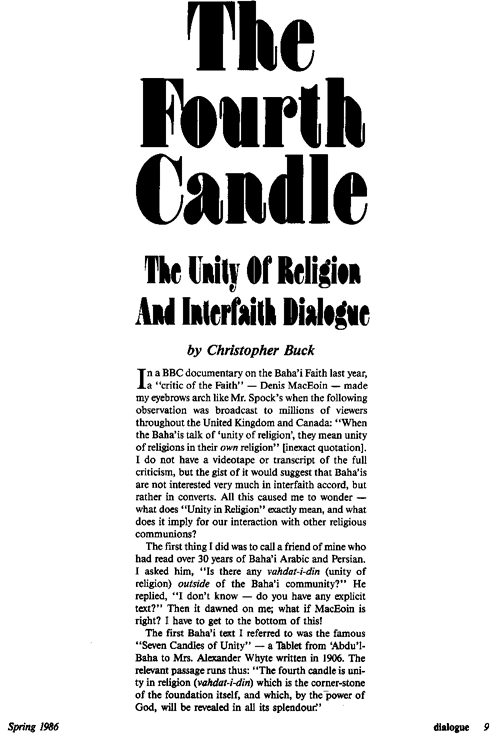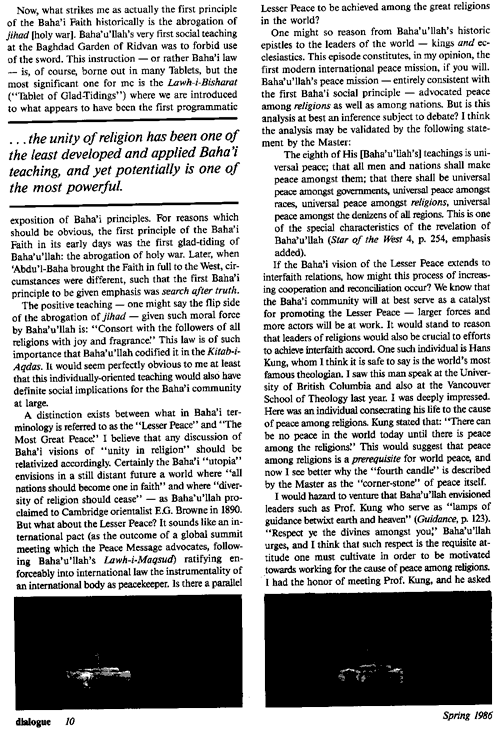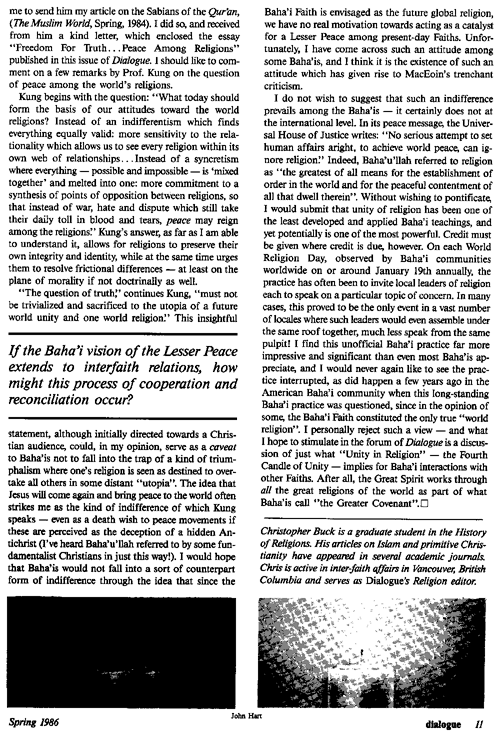
|
|
Abstract: What does "Unity in Religion" mean, and how does it apply for Bahá'ís' interactions with other religious communities? An essay inspired by Abdu'l-Bahá's Tablet "Seven Candles of Unity," utopia, Hans Kung, and the Lesser Peace. Notes: See also list of dialogue articles or image scans. |
The Fourth Candle:
The Unity of Religion and Interfaith Dialogue
by Christopher Buck
published in dialogue, 1:2, pages 9-11Los Angeles: 1986
The first thing I did was to call a friend of mine who had read over 30 years of Bahá'í Arabic and Persian. I asked him, “Is there any vahdat-i-din (unity of religion) outside of the Bahá'í community?” He replied, “I don’t know — do you have any explicit text?” Then it dawned on me; what if MacEoin is right? I have to get to the bottom of this!
The first Bahá'í text I referred to was the famous “Seven Candles of Unity”—a Tablet from 'Abdu'l-Bahá to Mrs. Alexander Whyte written in 1906. The relevant passage runs thus: “The fourth candle is unity in religion (vahdat-i-din) which is the corner-stone of the foundation itself, and which, by the power of God, will be revealed in all its splendour.”
Now, what strikes me as actually the first principle of the Bahá'í Faith historically is the abrogation of jihad [holy war]. Bahá'u'lláh’s very first social teaching at the Baghdad Garden of Riḍván was to forbid use of the sword. This instruction—or rather Bahá'í law—is, of course, borne out in many Tablets, but the most significant one for me is the Lawḥ-i-Bishárát (“Tablet of Glad-Tidings”) where we are introduced to what appears to have been the first programmatic exposition of Bahá'í principles. For reasons which should be obvious, the first principle of the Bahá'í Faith in its early days was the first glad-tiding of Bahá'u'lláh: the abrogation of holy war. Later, when 'Abdu'l-Bahá brought the Faith in full to the West, circumstances were different, such that the first Bahá'í principle to be given emphasis was search after truth.
The positive teaching—one might say the flip side of the abrogation of jihad—given such moral force by Bahá'u'lláh is: “Consort with the followers of all religions with joy and fragrance.” This law is of such importance that Bahá'u'lláh codified it in the Kitáb-i-Aqdas. It would seem perfectly obvious to me at least that this individually-oriented teaching would also have definite social implications for the Bahá'í community at large.
A distinction exists between what in Bahá'í terminology is referred to as the “Lesser Peace” and “The Most Great Peace.” I believe that any discussion of Bahá'í visions of “unity in religion” should be relativized accordingly. Certainly the Bahá'í “utopia” envisions in a still distant future a world where “all nations should become one in faith” and where “diversity of religion should cease”—as Bahá'u'lláh proclaimed to Cambridge orientalist E.G. Browne in 1890. But what about the Lesser Peace? It sounds like an international pact (as the outcome of a global summit meeting which the Peace Message advocates, following Bahá'u'lláh’s Lawḥ-i-Maqṣúd) ratifying enforceably into international law the instrumentality of an international body as peacekeeper. Is there a parallel Lesser Peace to be achieved among the great religions in the world?
One might so reason from Bahá'u'lláh’s historic epistles to the leaders of the world—kings and ecclesiastics. This episode constitutes, in my opinion, the first modern international peace mission, if you will. Bahá'u'lláh’s peace mission—entirely consistent with the first Bahá'í social principle—advocated peace among religions as well as among nations. But is this analysis at best an inference subject to debate? I think the analysis may be validated by the following statement by the Master:
The eighth of His [Bahá'u'lláh’s] teachings is universal peace; that all men and nations shall make peace amongst them; that there shall be universal peace amongst governments, universal peace amongst races, universal peace amongst religions, universal peace amongst the denizens of all regions. This is one of the special characteristics of the revelation of Bahá'u'lláh (Star of the West 4, p. 254, emphasis added).If the Bahá'í vision of the Lesser Peace extends to interfaith relations, how might this process of increasing cooperation and reconciliation occur? We know that the Bahá'í community will at best serve as catalyst for promoting the Lesser Peace—larger forces and more actors will be at work. It would stand to reason that leaders of religions would also be crucial to efforts to achieve interfaith accord. One such individual is Hans Kung, whom I think it is safe to say is the world’s most famous theologian. I saw this man speak at the University of British Columbia and also at the Vancouver School of Theology last year. I was deeply impressed. Here was an individual consecrating his life to the cause of peace among religions. Kung stated that: “There can be no peace in the world today until there is peace among the religions.” This would suggest that peace among religions is a prerequisite for world peace, and now I see better why the “fourth candle” is described by the Master as the “corner-stone” of peace itself.
I would hazard to venture that Bahá'u'lláh envisioned leaders such as Prof. Kung who serve as “lamps of guidance betwixt earth and heaven” (Guidance, p. 123). “Respect ye the divines amongst you,” Bahá'u'lláh urges, and I think that such respect is the requisite attitude one must cultivate in order to be motivated towards working for the cause of peace among religions. I had the honor of meeting Prof. Kung, and he asked me to send him my article on the Sabians of the Qur’an, (The Muslim World, Spring, 1984). I did so, and received from him a kind letter, which enclosed the essay “Freedom For Truth…Peace Among Religions” published in this issue of Dialogue. I should like to comment on a few remarks by Prof. Kung on the question of peace among the world’s religions.
Kung begins with the question: “What today should form the basis of our attitudes toward the world religions? Instead of an indifferentism which finds everything equally valid: more sensitivity to the relationality which allows us to see every religion within its own web of relationships.…Instead of a syncretism where everything—possible and impossible—is ‘mixed together’ and melted into one: more commitment to a synthesis of points of opposition between religions, so that instead of war, hate and dispute which still take their daily toll in blood and tears, peace may reign among the religions.” Kung’s answer, as far as I am able to understand it, allows for religions to preserve their own integrity and identity, while at the same time urges them to resolve frictional differences—at least on the plane of morality if not doctrinally as well.
“The question of truth,” continues Kung, “must not be trivialized and sacrificed to the utopia of a future world unity and one world religion.” This insightful statement, although initially directed towards a Christian audience, could, in my opinion, serve as a caveat to Bahá'ís not to fall into the trap of a kind of triumphalism where one’s religion is seen as destined to overtake all others in some distant “utopia”. The idea that Jesus will come again and bring peace to the world often strikes me as the kind of indifference of which Kung speaks—even as a death wish to peace movements if these are perceived as the deception of a hidden Antichrist (I’ve heard Bahá'u'lláh referred to by some fundamentalist Christians in just this way!). I would hope that Bahá'ís would not fall into a sort of counterpart form of indifference through the idea that since the Bahá'í Faith is envisaged as the future global religion, we have no real motivation towards acting as a catalyst for a Lesser Peace among present-day Faiths. Unfortunately, I have come across such an attitude among some Bahá'ís, and I think it is the existence of such an attitude which has given rise to MacEoin’s trenchant criticism.
I do not wish to suggest that such an indifference prevails among the Bahá'ís—it certainly does not at the international level. In its peace message, the Universal House of Justice writes: “No serious attempt to set human affairs aright, to achieve world peace, can ignore religion.” Indeed, Bahá'u'lláh referred to religion as “the greatest of all means for the establishment of order in the world and for the peaceful contentment of all that dwell therein”. Without wishing to pontificate, I would submit that unity of religion has been one of the least developed and applied Bahá'í teachings, and yet potentially is one of the most powerful. Credit must be given where credit is due, however. On each World Religion Day, observed by Bahá'í communities worldwide on or around January 19th annually, the practice has often been to invite local leaders of religion each to speak on a particular topic of concern. In many cases, this proved to be the only event in a vast number of locales where such leaders would even assemble under the same roof together, much less speak from the same pulpit! I find this unofficial Bahá'í practice far more impressive and significant than even most Bahá'ís appreciate, and I would never again like to see the practice interrupted, as did happen a few years ago in the American Bahá'í community when this long-standing Bahá'í practice was questioned, since in the opinion of some, the Bahá'í Faith constituted the only true “world religion.” I personally reject such a view—and what I hope to stimulate in the forum of Dialogue is a discussion of just what “Unity in Religion”—the Fourth Candle of Unity—implies for Bahá'í interactions with other Faiths. After all, the Great Spirit works through all the great religions of the world as part of what Bahá'ís call “the Greater Covenant.”
Christopher Buck is a graduate student in the History of Religions. His articles on Islam and primitive Christianity have appeared in several academic journals. Chris is active in inter-faith affairs in Vancouver, British Columbia and serves as Dialogue’s Religion editor.
 click for larger image |
 click for larger image |
 click for larger image |
|
|